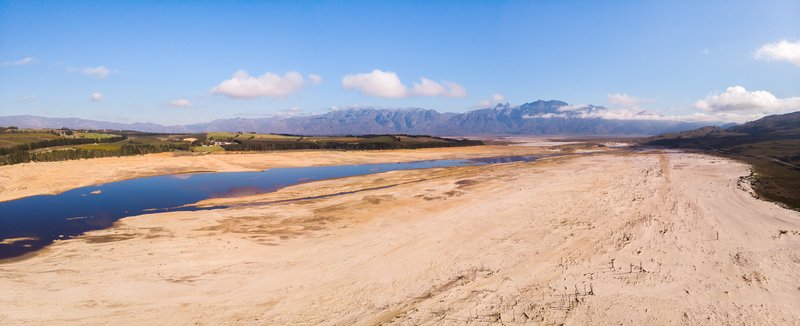by Olivia Hall

Researchers from Syracuse University and the United Kingdom found chemical clues in ancient South African sediments linking past atmospheric shifts to droughts that mirror Cape Town’s Day Zero crisis. Recent droughts have brought water sources like the Theewaterskloof Dam (pictured above) in South Africa dangerously close to drying up. (Courtesy: Shutterstock)
Key takeaways:
- Researchers analyzed ancient sediment from the coast of South Africa to uncover climate conditions similar to those behind Cape Town’s recent Day Zero drought.
- By measuring hydrogen isotopes in preserved plant molecules, the team revealed shifts in rainfall patterns tied to major changes in Earth’s atmospheric circulation during the Mid-Pleistocene Transition.
- The study, published in Nature Communications, offers new insights into how global climate change drives extreme droughts and provides guidance for improving climate models and preparing for future water crises.
Climate change is reshaping the global water cycle, disrupting rainfall patterns and putting growing pressure on cities and ecosystems. Some regions are grappling with heavier rainfall and flooding, while others face prolonged droughts that threaten public health, disrupt economies and increase the risk of political instability. In one recent example, a years-long drought between 2015 and 2020 brought Cape Town, South Africa, to the brink of running out of water—a moment officials dubbed “Day Zero.”
Scientists have long debated whether extreme events like the Cape Town water crisis are driven by human-caused climate change or are part of natural climate variability, with some models suggesting that global warming may indeed play a role.
“But a model is not the real world,” says Tripti Bhattacharya, Thonis Family Associate Professor in Syracuse University’s Department of Earth and Environmental Sciences (EES). “So we looked back in time.”
In a paper recently published in Nature Communications, Bhattacharya and a team of researchers, led by EES graduate Claire Rubbelke ’25 Ph.D. (and supported by undergraduates Lucy Weisbeck from the State University of New York College of Environmental Science and Forestry as well as, in earlier work, Ellen Jorgensen ’23), analyzed ancient plant matter preserved in a column of sediment drilled off the coast of South Africa. These molecules contain hydrogen isotopes from the rainfall that nourished the plants, providing a chemical fingerprint of past climate conditions.

The study focuses on the Mid-Pleistocene Transition, a 550,000-year period between 1.25 and 0.7 million years ago when Earth's glacial cycles and atmospheric composition underwent major shifts. The researchers found evidence that, during this time, dramatic changes in global atmospheric circulation—including contractions and expansions of the massive Hadley cell, which rises near the equator and sinks around 30 degrees latitude—produced wetting and drying conditions in Southern Africa. The latter correspond to the conditions experienced during Cape Town’s Day Zero crisis.
“We found that when the climate has changed dramatically in the past, it produced shifts analogous to the Day Zero drought,” Bhattacharya says. “This suggests that those types of events are really driven by global climate change.”
Rubbelke says the findings raise new questions about the future. “One big question I’m left with is whether these short droughts—and the Day Zero drought was relatively short-lived—will become more prolonged and eventually a permanent feature of the regional climate,” she says. “The fact that past droughts appear in the sediment record suggests they persisted for many years.”
In future work as a postdoctoral researcher, Rubbelke plans to conduct comparative studies on the opposite, eastern coast of Africa to better understand variations in rainfall across the continent. She also hopes to explore how shifting rainfall patterns may have shaped early human evolution in Southern Africa, home to key fossil sites like the Cradle of Humankind. Changes in vegetation and water availability could have influenced where hominin species lived and which ones survived.
Beyond its scientific insights, the research offers practical value for the present. Regions such as California, which share South Africa’s Mediterranean climate—marked by mild, wet winters and hot, dry summers—could benefit from a deeper understanding of past drought dynamics. “Climate models are the only tool we have for planning,” says Bhattacharya. “By testing how well they simulate past events, we can identify where they fall short—and ultimately improve our modeling capacity to better prepare for the future.”
Citation: Rubbelke, C.B., Bhattacharya, T., Farnsworth, A. et al. Southern Hemisphere subtropical front impacts on Southern African hydroclimate across the Mid-Pleistocene Transition. Nat Commun 16, 3501 (2025). https://doi.org/10.1038/s41467-025-58792-5
